Much has been written about what the Romans took from the Greeks. The Greeks still say they were the originators. The Romans still say they made it better.
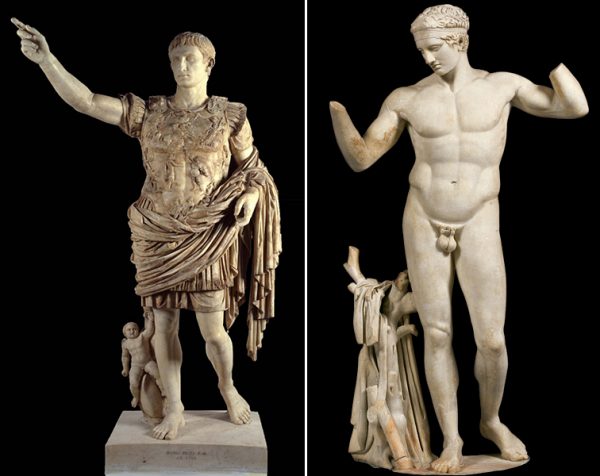
Greek sculpture was the idealized version of the perfect form, but the Romans considered the perfect form to include realistic portraits of themselves, which thankfully gives us an idea of what these people looked like.
Although Greek architecture was uniformly symmetrical, Roman architecture included vast expanses of concrete domes and arches.
The Greek Democracy was ruled by the wealthy aristocratic class, but the Romans were ruled by two parties, the Patricians (wealthy class) and the Plebeians (poor), although the Plebeians usually served the whims of the Patricians.
Romans incorporated the gods of Greek polytheism but they changed the names to make them, well, more Roman, and while Greeks believed their lives on Earth would be judged by the gods and their earthly deeds would determine their afterlife, many Romans believed in the afterlife they would themselves become gods.
The Greek influence in the Italian peninsula goes back to the 8th century BC when the Mycenean merchants began trading with Italian tribes. A century later, the Greek City-States were colonizing in southern Italy and Sicily. These colonies, known as Magna Grecia by the Romans, provided farm goods in exchange for linens, tools and pottery provided by the City-States back home on the Greek mainland.
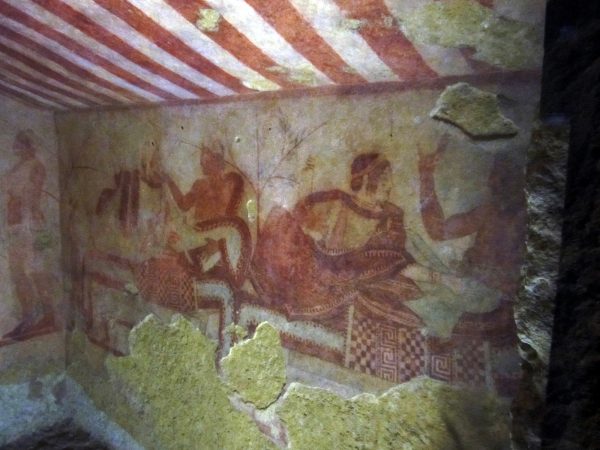
Interaction through trade came north to the Etruscans, the tribe that dominated central Italy from the 8th through the 6th centuries BC.
If you want to see the Greek influence on the Etruscan people, make a visit to Tarquinia and look through the tombs and the local museum. The decor is very Greek (see photo above of a Greek inspired Etruscan tomb in Tarquinia, a short distance north of Rome).
Although the common acceptance is that Rome was named for the founder Romulus, there are some who feel that Romulus never really existed, that he was just another hero fabrication of Roman lore. There are some who believe Roma came from the Etruscan word “Ruma“, which means ‘the tribe’. It makes sense.
The Etruscans had a major influence of the development of Rome. The last three Kings of Rome, Tarquinius Priscus, Servius Tullius and Tarquinius Superbus were all Etruscan.
The main difference between the Greek and Romans is that the Romans created an Empire. Greece was a collection of City-States that couldn’t figure out if they were friend or foe. There wasn’t a united Greece until the conquest of Philip II of Macedonia in the 4th century BC.
After incorporating ideas from the Greeks in the 8th century BC, the Roman Empire eventually incorporated Greece in the 2nd century BC.
In the 4th century BC, the forces of the Roman Republic conquered all of central Italy. After the 48 years of war with the Samnites, victory for Rome came in 295 BC, increasing the Empire territory through Campania and Puglia. The forces of Rome were now very close to the Greek settlements of the Southern Peninsula.
The Roman Republic sent an emissary to the Spartan Greek colony of Taras, modern day Taranto in Puglia, in a peaceful effort to take over the Greek colony but it ended up very badly. Taras, by the way was named after son of Poseidon.
The Roman envoy arrived to Taras in formal togas in an attempt to impress the Greeks, but the Greeks thought they looked ridiculous and broke into fits of laughter. One of the Greeks, according to the historian Cassius Dio, shit all over the formal clothes of the chief envoy, Lucius Postimius Megellus, who promised the clothes would be washed in the blood of the Greek colonists.
In 281 BC, Taras appealed to King Pyrrhus of Epirus (present day Greece/Albania) for protection against the imminent invasion of Rome.
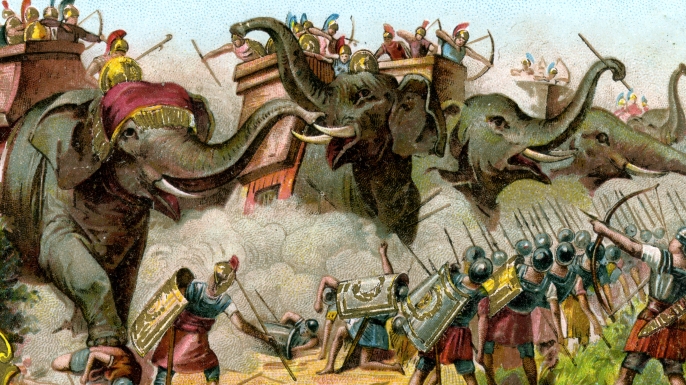
In the 279 BC battle of Asculum, Pyrrhus and his army of Elephants defeated the Romans but lost so many people he claimed that one more victory like this would ruin him. The Pyrrhic Victory definition is still used when a heavy loss questions the value of the victory.
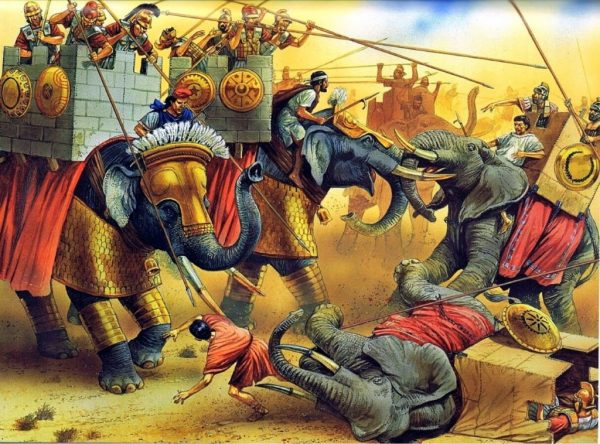
Six years later Rome regrouped and defeated Pyrrhus at the 275 BC Battle of Beneventum. According to Cassius Dio (who was born 430 years after the battle), the Romans became victorious after a wounded young elephant shook off its riders and went off to search for its mother, who upon seeing her wounded offspring became emotionally unstable, which caused confusion and disorientation to the rest of the elephants who also dumped their riders, giving the advantage to the Roman legions. Even if it’s not true, it’s a great story.
Rome now had possession of the (wealthy) Greek settlement of Taras and renamed it Tarentum.
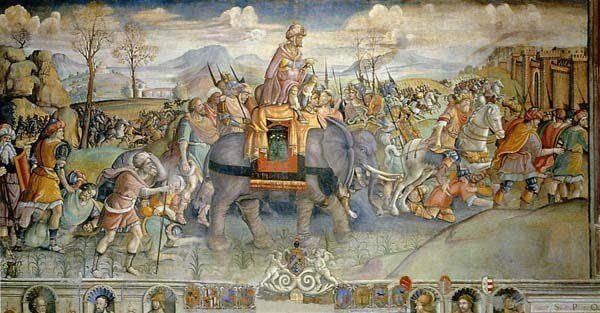
Ten years later, in 264 BC, after coming out victorious against Carthage in the first of the Punic Wars, Rome gained territory and Greek settlements in Sicily. At this point it looked like Rome would absorb all of the Greek colonies, but then in 218 BC, a 28 year old Hannibal Barca set out from his home of New Carthage (Cartagena, Spain) with 50,000 infantry, 9,000 cavalry and 37 elephants. He came up the coast of Spain, crossed the Alps and attacked Rome near Ticinus (modern day Pavia in Lombardia). It was round two in the Punic Wars with Carthage.
While the entire Roman military was occupied with Hannibal, King Philip V of Macedon, making his move to re-establish the Empire of Alexander the Great, aligned himself with Hannibal and attacked the Roman territories in Illyria (Dalmatian Coast).
Phillip V was a young, charismatic warrior, with so many similarities to Alexander the Great he was referred to as Philip the Great, even though, as it turned out, he really wasn’t that great.
With their hands full of Hannibal, Rome didn’t have the resources needed to fight Philip V and so they were forced into a treaty in 205 BC. If Philip broke his allegiance with Hannibal, Rome would yield Illyria to Macedonia and that’s what happened.
A year later, in 204 BC, Hannibal was defeated and in 200 BC, Rome returned to Macedonia. This time there was no treaty.
What’s most interesting about Phillip V’s defeat at the 197 BC Battle of Cynoscephalae was that it marked of the end of the Macedonian Phalanx, the battle formation that had successfully conquered Egypt to Uzbekistan for Alexander the Great.
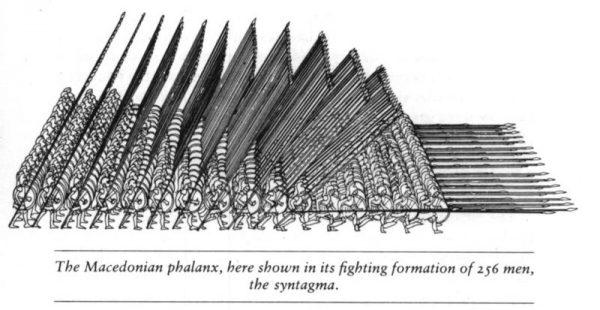 This close ranked formation of shields and interlocking 18 ft long spears moved like a tank, fending off missiles and spears. Mounted cavalry soldiers would guard the flanks and when the the enemy was dispersed by the phalanx, the cavalry would attack.
This close ranked formation of shields and interlocking 18 ft long spears moved like a tank, fending off missiles and spears. Mounted cavalry soldiers would guard the flanks and when the the enemy was dispersed by the phalanx, the cavalry would attack.
The Romans used the phalanx formation during the period of the Roman Kings but by the mid Republic, they switched to a formation consisting of small (maniple) formations of 60-120 men each in checkerboard formations. The flexible, faster and smaller units proved more successful when fighting in tighter hillier terrain.
The maniples lost a few battles to the phalanx early on but by the time Rome sent troops to fight in the Battle of Cynoscephalae they had perfected the formation. The slow moving Macedonian phalanx of Philip V was attacked and pulled apart.
Now with a stronghold in Macedonia, Rome pushed south into Peloponnese.
Corinth was the wealthiest city in Greece in the 2nd century BC. The city had a formidable Navy, an opportune location for wealthy trade and was renowned for ornate Corinthian architecture, black pottery and the thousand prostitutes of the Temple of Aphrodite, a lure for tourism. Corinthian leather didn’t come around until 1974. It was coined as a advertising gimmick for the 1975 Chrysler Cordoba.
In 146 BC, Rome finally destroyed Carthage in the third (and last) Punic War. They burnt the city to the ground. In the same year, the Roman General Lucius Mummius captured Corinth, killed all the men and sold the women and children into slavery. All that remained was rubble until Julius Caesar came in 44 BC and rebuilt the city as the colony of Laus Iulia Corinthiensis.
In 146 BC the Roman treasury was filled with loot from Carthage and Corinth. Back at home, the population increased. Temple ceilings were covered in gold and Rome’s 91km long Aqua Marcia aqueduct was completed. Things were looking up for the Roman Empire, at least until 91 BC when the client governments of conquered regions rebelled against Rome during the Social War (91-88 BC). When the Social War ended, Rome had to deal with Mithridates VI, the King of Pontus (Turkey) from 88 BC-66BC. Twenty years later the Roman Republic came to an end.
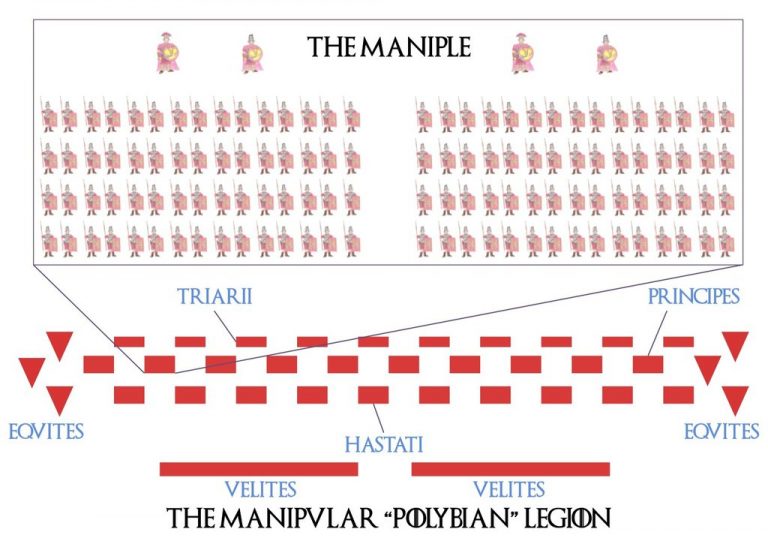
You must be logged in to post a comment.